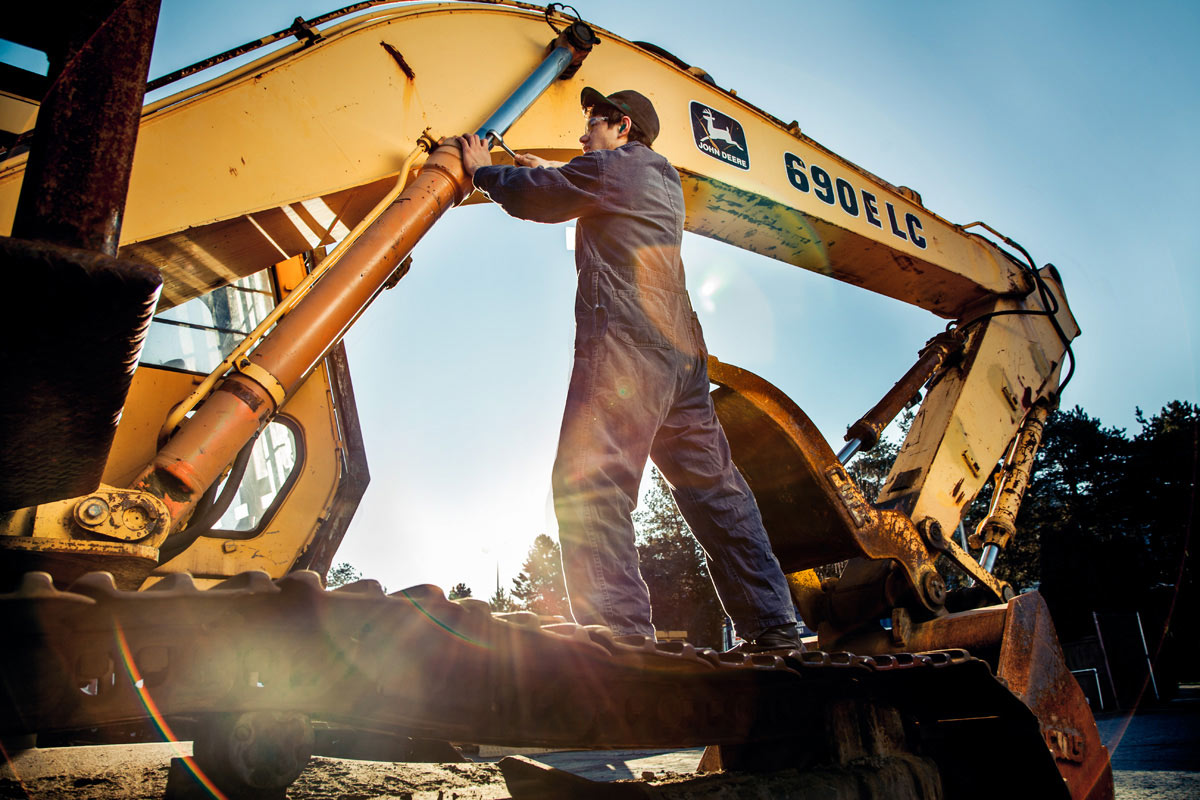Parts Technician (Red Seal)
Parts Technician
(Red Seal)

- How to follow proper health and safety requirements
- How to communicate effectively
- How to identify parts
- How to merchandise parts
- How to use equipment and procedures to handle materials
A Parts Technician enjoys using their strong systematic and analytical skills to oversee the many intricate procedures involved in ordering, warehousing and maintaining inventory control.
As a Parts Technician, you’re an organized person well-suited to overseeing the complex systems that ensure businesses properly order, track and store the various parts and supplies they need.
You’re a team player who works with retail service staff, sales staff and service technicians, who rely on your expertise to ensure they can properly manage the supply of parts and materials.
For more information regarding the other levels in this progressive trade, please refer to the following program pages:
Program Updates
June 2023: Program Update (Harmonization Implementation)
November 2022: A new Program Outline and Program Profile will be implemented on August 1, 2023. Please see OPSN 2022 026 for details.
Harmonized Program
information & resources
Harmonized Program
information & resources
In effect starting August 1, 2023
Exam Information
and Resources
Interprovincial Exam Information
Updates:
October 2023: Program Update (IP Exams aligned to 2020 Red Seal Occupational Standards (RSOS)). A Comparative Analysis detailing changes between the 2015 National Occupational Analysis (NOA) and 2020 RSOS can be found here.
Information:
Challenge the
trade
Challenge the
trade
If you have significant work experience in a trade but have never been certified in Canada, you may apply to challenge the certification. Learn more about How to Challenge a Skilled Trade.
OR
If you sponsor apprentices but have never been certified in Canada, you may request to supervise and sign-off apprentices when they are ready to be certified. Please refer to the application form on whether this trade qualifies.
Instructions
How to Apply
Application Form
Personal information and exams scheduling information (for challenge option)
Employer Declaration
Document of relevant work experience
Statutory Declaration
Attestation for self-employment/work experience when employer cannot be contacted
- Communication
- Coordination
- Parts identification and cataloguing
- Health and safety procedures
- Materials handling techniques and equipment
To get certified, you will need to sign up for technical training at an approved training provider in addition to on-the-job training.
Visit Trades Training BC and EducationPlannerBC for a comprehensive list of what programs are available in your trade at public and non-public schools.
Parts Technician 1
Parts Technician 1

- How to describe warehouse operations and requirements
- How to communicate effectively
- How to follow proper health and safety requirements
- How to receive, handle and fill orders for materials
- How to use equipment and procedures to handle materials
A Parts Technician 1 is a highly organized and systematic individual who enjoys using a hands-on approach to oversee complex inventory operations and procedures.
As a Parts Technician 1, you’ll be in an environment where you’re responsible for overseeing complex systems and procedures.
You'll apply a careful process to materials handling, using a range of procedures and equipment to receive, sort, store and ship goods. You’ll do all this—and more—while working closely with other team members to ensure the smooth and safe operation of the warehouse.
For more information regarding the other levels in this progressive trade, please refer to the following program pages:
Parts Technician 3 (Red Seal)
Program Updates
June 2023: Program Update (Harmonization Implementation)
November 2022: A new Program Outline and Program Profile will be implemented on August 1, 2023. Please see OPSN 2022 026 for details.
CofQ Exam Information
Program Information
& Resources
Program Information
& Resources
In effect starting August 1, 2023
Challenge the
trade
Challenge the
trade
If you have significant work experience in a trade but have never been certified in Canada, you may apply to challenge the certification. Learn more about How to Challenge a Skilled Trade.
OR
If you sponsor apprentices but have never been certified in Canada, you may request to supervise and sign-off apprentices when they are ready to be certified. Please refer to the application form on whether this trade qualifies.
Instructions
How to Apply
Application Form
Personal information and exams scheduling information (for challenge option)
Employer Declaration
Document of relevant work experience
Statutory Declaration
Attestation for self-employment/work experience when employer cannot be contacted
- Communication
- Coordination
- Warehouse operations
- Health and safety procedures
- Materials handling techniques and equipment
To get certified, you will need to sign up for technical training at an approved training provider in addition to on-the-job training.
Visit Trades Training BC and EducationPlannerBC for a comprehensive list of what programs are available in your trade at public and non-public schools.
Instrumentation and Control Technician
Instrumentation &
Control Technician

- How to consult manufacturer manuals, circuit diagrams and blueprints
- How to test and maintain instruments used for measuring and controlling flow, level, pressure, temperature, chemical composition and other variables
- How to calibrate components and instruments according to manufacturer specifications
- How to perform scheduled preventive maintenance work and complete test and maintenance reports
- How to install control and measurement instruments on existing and new plant equipment and processes
Instrumentation and Control Technicians understand what all the dials, gauges and measuring devices are on any large piece of machinery, to ensure all runs smoothly.
As an Instrumentation and Control Technician, you’ll use your logical approach to repair, maintain, calibrate, adjust and install the dials, sensors and other instrumentation that measure and control industrial/commercial machinery.
You’ll work anywhere that uses complicated machinery—from pulp and paper plants to power plants, mines, manufacturing companies and health services.
Program Updates
None
Program Information
and Resources
Program Information
and Resources
Exam Information
and Resources
Find exam-related information and resources under each menu item below.
Information:
Information:
Information:
Updates:
December 2023: Program Update (IP Exams aligned to 2020 Red Seal Occupational Standards (RSOS)). A Comparative Analysis detailing changes between the 2013 NOA and 2020 RSOS can be found here.
Information:
Challenge the
Trade
Challenge the
Trade
If you have significant work experience in a trade but have never been certified in Canada, you may apply to challenge the certification. Learn more about How to Challenge a Skilled Trade.
OR
If you sponsor apprentices but have never been certified in Canada, you may request to supervise and sign-off apprentices when they are ready to be certified. Please refer to the application form on whether this trade qualifies.
Instructions
How to Apply
Application Form
Personal information and exams scheduling information (for challenge option)
Employer Declaration
Document of relevant work experience
Statutory Declaration
Attestation for self-employment/work experience when employer cannot be contacted
- Critical thinking and troubleshooting
- Analytical instrumentation
- Measuring and indicating devices
- Installation and maintenance of pneumatic, hydraulic, and electronic systems
- Communications, networking and signal transmission systems
To get certified, you will need to sign up for technical training at an approved training provider in addition to on-the-job training.
Visit Trades Training BC and EducationPlannerBC for a comprehensive list of what programs are available in your trade at public and non-public schools.
Industrial Mechanic (Millwright)
Industrial Mechanic
(Millwright)

- How to read and interpret blueprints, diagrams and schematic drawings
- How to inspect and examine machinery and equipment for irregularities and malfunctions
- How to install, align, dismantle and move stationary industrial machinery and mechanical equipment such as pumps, fans, tanks, conveyors, furnaces and generators
- How to maintain power transmission, vacuum, hydraulic and pneumatic systems, and programmable logic controls
- How to clean, lubricate and perform other routine maintenance work on machinery
Millwrights are systematic fixers whose expertise covers a wide range of tasks. In fact, their work borrows from many other trades—electricians, plumbers, machinists and mechanics—all rolled into one.
As a Millwright, you’ll install, repair, and maintain a huge range of machinery.
This will require a mechanical aptitude, as well as a knack for working with machinery and troubleshooting. You’ll be highly adaptable, learning the skills to work on specialized machines.
Whether working on a broken conveyor belt or repairing a skill lift, you’ll enjoy the diversity of your job.
Program Updates
July 2022: Transition Update (Current/pre-harmonized program closes)
November 2017: Transition Plan
Program Information
and Resources
Program Information
and Resources
Exam Information
and Resources
Find exam-related information and resources under each menu item below.
Information:
Information:
Information:
Challenge the
Trade
Challenge the
Trade
If you have significant work experience in a trade but have never been certified in Canada, you may apply to challenge the certification. Learn more about How to Challenge a Skilled Trade.
OR
If you sponsor apprentices but have never been certified in Canada, you may request to supervise and sign-off apprentices when they are ready to be certified. Please refer to the application form on whether this trade qualifies.
Instructions
How to Apply
Application Form
Personal information and exams scheduling information (for challenge option)
Employer Declaration
Document of relevant work experience
Statutory Declaration
Attestation for self-employment/work experience when employer cannot be contacted
- Equipment installation and maintenance
- Cutting, fitting and fabricating
- Electricity and electronics theory
- Use of specialized tools and equipment
- Knowledge of lubricants, seals, bearings, power transmissions, compressors, and pumps
To get certified, you will need to sign up for technical training at an approved training provider in addition to on-the-job training.
Visit Trades Training BC and EducationPlannerBC for a comprehensive list of what programs are available in your trade at public and non-public schools.
Heavy Duty Equipment Technician
Heavy Duty Equipment
Technician

- How to adjust equipment and attach components
- How to test and inspect heavy equipment for faults and malfunctions
- How to repair and replace defective parts, components and systems
- How to clean, lubricate and maintain heavy equipment and attachments
Heavy Duty Equipment Technicians are behind-the-scenes experts. They are incredibly versatile and resourceful, as they work with a wide range of equipment, making sure everything runs safely.
As a Heavy Duty Equipment Technician, you’ll spend each day working on a range of tasks that test your analytical and mechanical skills.
You’ll use your systematic approach to repair and maintain equipment used in a wide range of industries, from transportation to forestry, manufacturing, farming, mining and construction. This includes graders, loaders, shovels, tractors, forklifts, and more.
Program Updates
- December 2023: Program Update (Competency Migration Chart)
- November 2023: For more information regarding transition, please see the Program Update.
- June 2023: OPSN 2023 008 (Updated Program Profile and Program Outline)
- April 2023: Program Update (Revised Target Implementation Date)
- OPSN Archives
Harmonized (2024) Program Information
and Resources
Harmonized (2024) Program Information
and Resources
In effect starting April 1, 2024
Exam Information
AND RESOURCES
Find exam-related information and resources under each menu item below.
Updates:
- March 2024: OPSN 2024 006 (HMT Common Core Level 1 SLE Launch)
Information:
- Exam Breakdown
- Acronyms & Formulas Sheet
- Code book required: none
Updates:
- None
Information:
- National Occupational Analysis
- Red Seal Exam Preparation Guide
- Red Seal Exam Breakdown (online)
- Red Seal Exam Breakdown (pdf)
- Code book provided: none
Challenge the
Trade
Challenge the
Trade
If you have significant work experience in a trade but have never been certified in Canada, you may apply to challenge the certification. Learn more about How to Challenge a Skilled Trade.
OR
If you sponsor apprentices but have never been certified in Canada, you may request to supervise and sign-off apprentices when they are ready to be certified. Please refer to the application form on whether this trade qualifies.
Instructions
How to Apply
Application Form
Personal information and exams scheduling information (for challenge option)
Employer Declaration
Document of relevant work experience
Statutory Declaration
Attestation for self-employment/work experience when employer cannot be contacted
- Repair and maintenance
- Troubleshooting and monitoring
- Coordination
- Machine servicing
- Knowledge of machine systems
To get certified, you will need to sign up for technical training at an approved training provider in addition to on-the-job training.
Visit Trades Training BC and EducationPlannerBC for a comprehensive list of what programs are available in your trade at public and non-public schools.
Motorcycle Technician
Motorcycle
Technician

- How to inspect and test engines and other mechanical components
- How to repair and replace engines, drive trains, suspension and electrical systems
- How to adjust and test repaired systems
- How to perform preventative maintenance
- How to customize and rebuild
Motorcycle Technicians are analytical and hands-on fixers who love working on motorcycles and other small vehicles, keeping them running smoothly and safely.
As a Motorcycle Technician, you’ll work on motorcycles and other small vehicles such as scooters and all-terrain vehicles.
Every day, you’ll inspect, diagnose, repair and maintain engines, transmissions and other systems. Your work will take place mostly on a busy shop floor with other Technicians, as you use your expert knowledge to manage a broad range of tasks.
Program Updates
February 2024: Transition Update (Year 3)
November 2021: Transition Plan
June 2021: A new Program Outline and Program Profile will be implemented April 1, 2022. Please see OPSN-2021-006 for details.
The Motorcycle Technician Program Has Changed
Level 1 - Harmonized*
Level 2 - Harmonized*
Level 3 - Harmonized*
Level 4 - Current**
*Harmonized = Program stream with re-aligned content beginning in April 2022
**Current = Program stream for apprentices who've completed level 1 training before April 2022
Harmonized Program
Information & Resources
Harmonized Program
Information & Resources
Exam Information
and Resources
Find exam-related information and resources under each menu item below.
Updates:
- December 2023: OPSN 2023 011 (HL1 SLE Launch)
Information:
- Exam Breakdown
- Acronyms
- Code Book required: none
Updates:
- To be implemented.
Updates:
- To be implemented.
Updates:
February 2022: OPSN 2022 004 Removal of the Level 4 Standard Level Exam (SLE) from the Harmonized program.
Information:
Updates:
August 2023: Program Update (IP Exams aligned to 2020 Red Seal Occupational Standards (RSOS)). The Comparative Analysis details changes between the 2012 National Occupational Analysis (NOA) and 2020 RSOS.
Information:
Program Information
Program Information
Information for the Current (pre-harmonized) program (Motorcycle and Power Equipment Technician).
Challenge the
Trade
Challenge the
Trade
If you have significant work experience in a trade but have never been certified in Canada, you may apply to challenge the certification. Learn more about How to Challenge a Skilled Trade.
OR
If you sponsor apprentices but have never been certified in Canada, you may request to supervise and sign-off apprentices when they are ready to be certified. Please refer to the application form on whether this trade qualifies.
Instructions
How to Apply
Application Form
Personal information and exams scheduling information (for challenge option)
Employer Declaration
Document of relevant work experience
Statutory Declaration
Attestation for self-employment/work experience when employer cannot be contacted
- Bearing design, construction and service
- Wheels, tires and suspension installation and maintenance
- Brake, electronic and exhaust systems
- Gasket and seal construction and service
- Starting, charging, engine, transmission and hydraulic systems
To get certified, you will need to sign up for technical training at an approved training provider in addition to on-the-job training.
Visit Trades Training BC and EducationPlannerBC for a comprehensive list of what programs are available in your trade at public and non-public schools.
Sprinkler Fitter
Sprinkler
Fitter

- How to read and interpret drawings, specifications and fire codes
- How to select, measure, cut, ream and thread pipe
- How to join pipes and piping sections using soldering and welding equipment
- How to install valves, alarms, controls and associated equipment
- How to test systems for leaks using air or liquid pressure equipment
Sprinkler Fitters have a real impact on the safety of their communities. They are the tradespeople who make sure all buildings have the proper sprinkler systems in place.
As a Sprinkler Fitter, you’ll be comfortable taking on a role of great responsibility—designing, assembling and installing sprinkler systems.
You’ll apply stringent safety regulations to your work, ensuring each system you install and repair is in top working order. Many systems can be quite complicated, and you’ll be the one who makes sure each one can save buildings and even lives, if needed.
Program Updates:
April 1, 2019: The Harmonized Program is in effect
February 2019: Program Update (Foundation and Level 1 Implementation)
December 2018: Program Update (Cross-program credits)
September 2018: Transition Plan
March 2018: OPSN 2018 004 (Harmonization)
Program Information
and resources
Program Information
and resources
Exam Information
AND RESOURCES
Find exam-related information and resources under each menu item below.
Updates:
- August 2023: OPSN-2023-009 (Sprinkler Fitter HL2 NFPA Code Book Update)
- January 2020: OPSN 2019 021 (HL1 and HL2 SLE Launch)
Information:
Updates:
- None
Information:
Challenge the
trade
Challenge the
trade
If you have significant work experience in a trade but have never been certified in Canada, you may apply to challenge the certification. Learn more about How to Challenge a Skilled Trade.
OR
If you sponsor apprentices but have never been certified in Canada, you may request to supervise and sign-off apprentices when they are ready to be certified. Please refer to the application form on whether this trade qualifies.
Instructions
How to Apply
Application Form
Personal information and exams scheduling information (for challenge option)
Employer Declaration
Document of relevant work experience
Statutory Declaration
Attestation for self-employment/work experience when employer cannot be contacted
- WHMIS and WorkSafe BC compliance
- Cutting, brazing, and soldering equipment use
- Project planning according to industry codes, regulations and standards
- Sprinkler components installation
- Water supply and sprinkler systems installation
To get certified, you will need to sign up for technical training at an approved training provider in addition to on-the-job training.
Visit Trades Training BC and EducationPlannerBC for a comprehensive list of what programs are available in your trade at public and non-public schools.
For a list of all approved non-public training providers, visit this page.
Security Systems Technician
Security Systems
Technician

- How to use safe work practices
- How to use hand and power tools
- How to use test instruments, fasteners, sealants and surface fillers
- How to apply codes and regulations
- How to install security systems
Security Systems Technicians take care of the systems that take care of us. They are experts who ensure every system works as intended, with no compromise on safety and security.
As a Security Systems Technician, you’ll draw on your persistent style as you plan, troubleshoot and coordinate the installation, repair and maintenance of electronic security alarm systems.
You'll be comfortable working independently, as you reference each task back to various building codes and regulations, and you’ll anticipate the elements that go into each system as you design it.
Please be advised that in order to work in the Security System Technician industry, it is required that an individual holds a valid license or exemption from licensing from the Ministry of Justice and act in accordance with the provisions of the Security Services Act and regulations administered by Ministry of Public Safety and Solicitor General, Policing and Community Safety Branch, Security Programs and Police Technology Division. Visit their website
Program Updates
OPSN 2021-005 CEC version for CofQ exam
Certificate of Qualification (CofQ) Exam Breakdown
Program Information
and Resources
Program Information
and Resources
Challenge the
Trade
Challenge the
Trade
If you have significant work experience in a trade but have never been certified in Canada, you may apply to challenge the certification. Learn more about How to Challenge a Skilled Trade.
OR
If you sponsor apprentices but have never been certified in Canada, you may request to supervise and sign-off apprentices when they are ready to be certified. Please refer to the application form on whether this trade qualifies.
Instructions
How to Apply
Application Form
Personal information and exams scheduling information (for challenge option)
Employer Declaration
Document of relevant work experience
Statutory Declaration
Attestation for self-employment/work experience when employer cannot be contacted
- Critical thinking
- Coordination and troubleshooting
- Safe work practices
- Electrical theory
- Security system design and installation
To get certified, you will need to sign up for technical training at an approved training provider in addition to on-the-job training.
Visit Trades Training BC and EducationPlannerBC for a comprehensive list of what programs are available in your trade at public and non-public schools.
For a list of all approved non-public training providers, visit this page.
Saw Filer Endorsement: Benchperson
Saw Filer
Endorsement: Benchperson

- How to measure tools, apply formulas and calculate strain
- How to maintain cooling and hydraulic systems
- How to level and tension band saws
- How to set up and maintain band saw benches
- How to align and maintain band mills
Benchpersons are responsible for setting up and maintaining the various types of band saws that cut and shape wood. They are comfortable working with their hands, and systematic.
As a Benchperson, you’ll be a highly analytical expert who uses a hands-on approach to maintain the required cutting standard for band saws.
In this unique role, you’ll draw on your organized and mechanical nature to carefully inspect band saws to ensure they are level, straight and properly tensioned. You’ll maintain and align machine centres to ensure they operate properly.
Program Updates
Endorsement Exam Information
Program Information
and Resources
Program Information
and Resources
Challenge the
Trade
Challenge the
Trade
If you have significant work experience in a trade but have never been certified in Canada, you may apply to challenge the certification. Learn more about How to Challenge a Skilled Trade.
OR
If you sponsor apprentices but have never been certified in Canada, you may request to supervise and sign-off apprentices when they are ready to be certified. Please refer to the application form on whether this trade qualifies.
Instructions
How to Apply
Application Form
Personal information and exams scheduling information (for challenge option)
Employer Declaration
Document of relevant work experience
Statutory Declaration
Attestation for self-employment/work experience when employer cannot be contacted
- Safe work practices
- Math
- Saw basics
- Band saw benches, tensioning and levelling
- Quality control
To get certified, you will need to sign up for technical training at an approved training provider in addition to on-the-job training.
Visit Trades Training BC and EducationPlannerBC for a comprehensive list of what programs are available in your trade at public and non-public schools.
Saw Filer
Saw Filer

- How to measure tools, apply formulas and calculate strain
- How to use saw filing tools, align teeth, use shapers, and identify problems
- How to use band, circular, gang and chain saws
- How to use grinding wheels and knives
- How to weld saws, inspect and repair chains
Saw Filers are analytical tradespeople who work on the complex machinery that shapes our lumber industry. They’re masters in quality control, approaching every task with safety in mind.
As a Saw Filer, you’ll be in your element while you carefully and methodically work through the various processes to sharpen, fix and maintain saws.
You’re very systematic, using a hands-on approach that follows strict safety guidelines and steps. You’re also resourceful, able to apply saw filing techniques in a range of situations, knowing that your mechanical approach will ensure success.
Program Updates
Program Information
and Resources
Program Information
and Resources
Exam Information
And Resources
Find exam-related information and resources under each menu item below.
Information:
Information:
Challenge the
Trade
Challenge the
Trade
If you have significant work experience in a trade but have never been certified in Canada, you may apply to challenge the certification. Learn more about How to Challenge a Skilled Trade.
OR
If you sponsor apprentices but have never been certified in Canada, you may request to supervise and sign-off apprentices when they are ready to be certified. Please refer to the application form on whether this trade qualifies.
Instructions
How to Apply
Application Form
Personal information and exams scheduling information (for challenge option)
Employer Declaration
Document of relevant work experience
Statutory Declaration
Attestation for self-employment/work experience when employer cannot be contacted
- Safe work practices
- Math
- Saw filing equipment and tools
- Saw basics
- Quality control
To get certified, you will need to sign up for technical training at an approved training provider in addition to on-the-job training.
Visit Trades Training BC and EducationPlannerBC for a comprehensive list of what programs are available in your trade at public and non-public schools.
For a list of all approved non-public training providers, visit this page.
